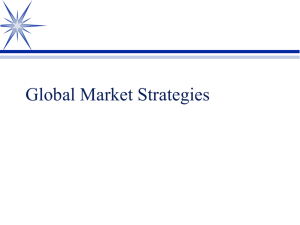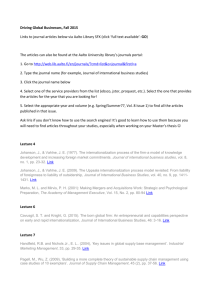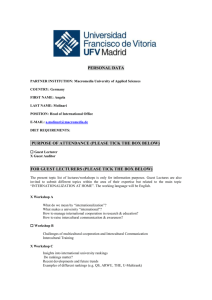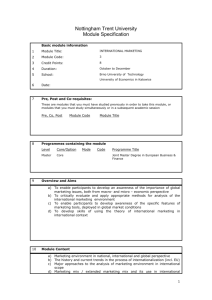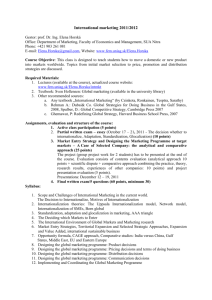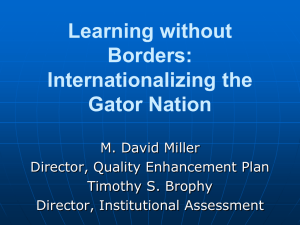Mirosław Jarosiński CONTEMPORARY MODELS OF POLISH
advertisement
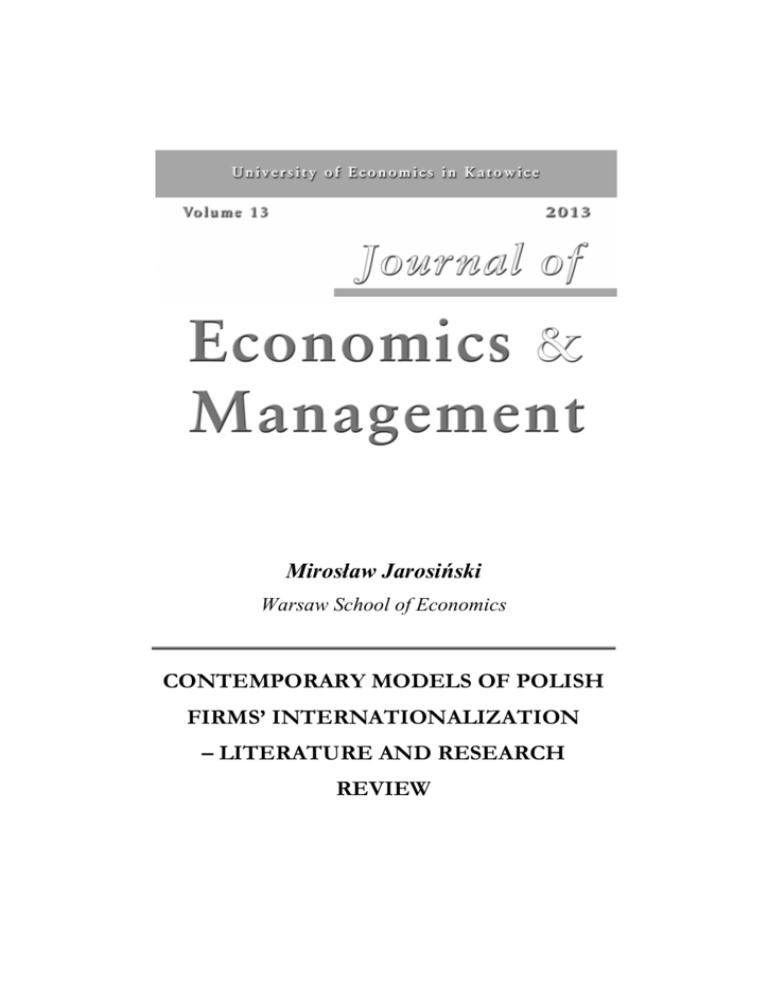
Mirosław Jarosiński Warsaw School of Economics CONTEMPORARY MODELS OF POLISH FIRMS’ INTERNATIONALIZATION – LITERATURE AND RESEARCH REVIEW M IROSŁAW J AROSIŃSKI Abstract A review of the literature and research on internationalization of Polish companies as well as author’s own studies indicate that at present two models of internationalization coincide in Poland: a stages model and a model of early internationalization. It is very interesting because the model of early internationalization appeared in Poland at the same time as in developed countries, i.e. at the beginning of the 1990s. Yet one could expect that all Polish companies should develop according to the stages model since internationalization was something totally new for Polish companies in the 1990s. The author postulates more intensive and more extensive research on born globals in Poland to reduce the gap between research on this topic in developed countries and in Poland. Also a cross-country study of born globals in CEE is proposed with comparison of results to studies on born globals from other European countries. Keywords: stages model of internationalization, early internationalization, born globals Introduction The internationalization of companies has been the subject of research and discussions all over the world for several decades now. The literature review reveals that researchers have been trying to identify common behavior of exporting companies and then companies making investments abroad as well as the reasons for such behavior for years. Several internationalization models were developed out of which two models dominate in the literature nowadays: the stages model and the early internationalization model. There are two objectives of the article. The first objective is to show that the behavior of Polish companies undertaking internationalization does not vary from companies deriving from more developed countries and that at present the same models describe their behavior. The second objective is to indicate possible research areas on both models in the future. The article first describes some theory on models of internationalization and then the Polish research on the application of these models by Polish companies is presented. They are followed by conclusions on the future research paths on Polish companies’ models of internationalization. 58 CONTEMPORARY MODELS OF POLISH FIRMS’ INTERNATIONALIZATION… 1. Development of internationalization models The first attempts to explain the behavior of companies on international markets from microeconomic point of view are believed to be Hymer’s doctoral thesis on internationalization of American enterprises and the theory of monopolistic advantage developed by Hymer and Kindleberger, as well as the theory of international product life cycle developed by Vernon (Jarosiński, 2012b, pp. 8-9.) Later other efforts to explain internationalization were undertaken eventually to produce two parallel and independent streams of research in the US and in Europe leading to the development of stage theories. At present the International Business literature most often quotes two types of stage models: innovative models (Bilkey and Tesar, 1977; Cavusgil, 1980; Czinkota, 1982; Reid, 1981) and process models (Johanson and Wiedersheim-Paul, 1975, Johanson and Vahlne, 1977, 1990, 2003, 2006, 2009) both types of which conceptualising in a similar way that international development of companies takes place “in gradual and sequential stages based on a series of incremental commitment decisions depending on perception, expectations, experience, managerial capacity, etc.” (Rasmussen and Madsen, 2002, p. 3). In all innovative models the decision to start exports is an innovation in relation to operations on a home market. The development on international markets takes a relatively long time because of the aversion of managers to take risks and their inability to gain market knowledge in an effective way. On the other hand all process models „emphasise stepwise and highly deliberative internationalization that is comparatively slow, owing to incremental adaptations to environmental conditions” (Knight et al., 2004, p. 646). The process models “specify that, initially, firms enter markets that are similar to the home country and than target those with increasing psychic distance” (Knight et al., 2004, p. 646). The more markets a company enters the more knowledge and experience the company gains which leads to new foreign entries. As this happens in a loop one may speak about the learning process and the process of development on international markets. Hence the name of the process models. A review of International Business literature of the end of 1980s indicates a strong belief of researchers in stage development of companies from small or medium-sized home based enterprises to big multinational companies with a “framework” requirement that a company has to become big enough to enter international markets. It is even stated that “the existence of a gradual development process is one of the few solid conclusions in international marketing research” (Moen and Servais, 2002, pp. 49-50). This is however not a lasting 59 M IROSŁAW J AROSIŃSKI conclusion since 1990s bring a new model of development on international markets: early internationalization which contradicts the stage model. The notion “early internationalization ” describes the situation in which a company starts exporting or any other form of international operations soon after its establishment. Such a company is most often referred to as an “international new venture – INV” or, as it will be further called in this article: a “born global – BG” Such a company, by definition, is a “young” and as a result of this still small or by some chance medium-sized company which contradicts the assumptions of stage models that to start exporting a company has to grow on national market first learning how to do business at all and after that once it accumulates enough knowledge and experience take the first steps abroad. What is interesting born globals being, as it has already been stated, small and young companies, not only take the first steps abroad early but also very often they start operating in many countries from the very beginning which is another contradiction to the assumptions of stage models that companies conquer international markets one by one in a long period of time. A great number of studies carried out in many countries in 1990s proved the growing popularity of early internationalization. Although at first some researches pronounced that “gradual internationalisation is dead” (Hashai and Almor, 2004, p. 467) careful review of international literature proves that both models exist parallel to each other, although gradual internationalization happens nowadays at a faster pace. 2. Internationalization models in Poland Although both above mentioned models of internationalization have existed together for the past two decades, the research referring to both models in Poland does not have a long history. To the best knowledge of the author of this article, first Polish research comparing the two models did not start earlier then in the middle of the last decade. The first publication to speak about the research referring to stage model and the model of early internationalization was by Morawczyński (2007), who also compared born globals and “traditionally” internationalized companies (Morawczyński 2008). Both articles described his research from 2004 on 107 small and medium-sized manufacturing companies in Małopolska region. The author’s review of earlier publications on research on internationalization of Polish companies did not show references to the models of internationalization. 60 CONTEMPORARY MODELS OF POLISH FIRMS’ INTERNATIONALIZATION… Morawczyński (2008) found out that almost every second company in his sample was a born global. Generally he observed that Polish companies entered international markets faster than it had been envisaged in the stage model. Morawczyński (2007, p. 79) also noticed that this phenomenon was also observed in other countries. He believes that the phenomenon has been strengthened in Poland by the transformation and liberalisation of Polish economy. Comparing born globals and “traditionally” internationalised companies Morawczyński (2008) identified some differences between the two groups of companies generally similar to those described in the literature on early internationalization. Other research referring to both models was done by Przybylska (2010) as well as Nowiński & Nowara (2010). Przybylska (2010) studied 53 Polish exporters, among which she identified 18 born globals (34%). Przybylska (2010, p. 72) concluded that companies undertaking internationalization in a traditional way still existed, although their behavior had recently changed. At the same time she confirmed the existence of a new model of early internationalization. Nowiński & Nowara (2010) studied 45 Polish small and medium-sized exporters and identified 15 born globals (33%), some of which were established before 2000. Nowiński & Nowara (2010, pp. 12-13) concluded that nowadays Polish companies would undertake internationalization generally faster then before, but they did not manage to determine unambiguously if early internationalization coincide with gradual internationalization in Poland. Kosowska & Bera (2011) investigated 262 small and medium-sized enterprises from all over Poland operating internationally. Their research generally concerned application of financial strategies by companies doing business abroad, but among the others they found out that 2/3 of the companies in the sample were internationalizing according to the stages model and 1/3 of the companies in the sample – according to the model of early internationalization. Jarosiński (2013) examined 241 Polish medium and large companies coming from various industries from all over Poland and representing production, trade and service sectors that were operating on international markets. Among the others he concluded that the internationalization processes of the companies in the sample could be described respectively by either a stages model or early internationalization model. In the sub-sample of 84 Polish companies (with a majority of Polish capital) created after 1987 Jarosiński identified 32 born globals, characterised them and compared to the other companies in the subsample. The born globals in the sample were more internationalised than the other companies in the sample in every aspect (they served more markets and more regions, their share of foreign sales in total sales was higher, etc.), but ge- 61 M IROSŁAW J AROSIŃSKI nerally the differences between both groups were not as big as it had been expected on the basis of the literature. Besides the above mentioned research there have been two other studies concentrating rather on the model of early internationalization. Kraśnicka et al. (2008) investigated 100 small and medium-sized enterprises from various industries from Silesia region, among which she identified 12 born globals which constituted approximately 43% of all international companies in the sample. Kraśnicka et al. (2008, p. 92) acknowledged that there existed a model of early internationalization in Poland. Jarosiński (2012a) also confirmed the existence of born globals in Poland as well as Cieślik et al. (2011) identified born globals in their research. On the other hand Romanowska et al. (2011) studied internationalization of Polish capital groups using Uppsala model (the stage model) as a benchmark. The above quoted research on Polish internationalised companies confirms that one can identify among them those developing according to the stages model and according to early internationalization model. What’s more the existing research (Nowiński and Nowara, 2010; Jarosiński, 2013) reported appearance of born globals (companies representing early internationalization model) about the same time as in developed countries, i.e. in the first half of 1990s. The existence of the phenomenon of born globals in Poland in early 1990s is very surprising. The historical context of centrally planned economy in Poland until 1989 suggests that internationalization has been an innovation for almost all Polish companies after 1989. Until that time foreign trade was a monopoly of the state and only special companies called Foreign Trade Enterprises were privileged to operate directly abroad. Of course many Polish companies exported before that time, but it was mainly exports to other socialist countries which was not such a challenge as it would have been when exporting to market economies. What’s more they had to use Foreign Trade Enterprises as intermediaries. Therefore the numbers quoted by Cieślik and Kaciak (2009) who investigated companies exporting commodities in the years 1989-2003 are startling. The number of Polish direct exporters has risen in the stated period almost ninety fold. Cieślik and Kaciak found out that that Foreign Trade Enterprises whose commodity exports share was 95% in 1989 contributed only in 10% to Polish commodity exports in 2003. Private Polish companies established before 1989 kept their average 4.8% share in exports between 1989 and 2003. At the same time there appeared 18,896 exporting start-ups which contributed to 32% of Polish commodity exports by 2003. Out of this number 8717 were instant exporters* and 5433 were quick exporters**. It is surprising that these new ventures * ** Firms that started exporting in their first year of operations. Firms that started exporting in their second or third year of operations. 62 CONTEMPORARY MODELS OF POLISH FIRMS’ INTERNATIONALIZATION… were able to internationalize so quickly. Although Cieślik and Kaciak did not investigate it one can expect that some of the companies were born globals. Cieślik’s research as well as Jarosiński’s research indicates that some of the companies established in 1990s have already planned either to concentrate on exports from the very beginning or to treat exports as an important source of revenues besides home sales. What can puzzle is the fact that those companies did not have huge capital at the starting point nor their founders had much entrepreneurial or especially foreign experience before. Some of them did not speak foreign languages at first and some were only limited to Russian. Thus, one could expect that these companies would rather develop gradually. Conclusion The author’s extensive studies of Polish publications on internationalization of Polish companies with particular emphasis on those concentrating on the models of internationalization indicate that both the stages model and the model of early internationalization exist in Poland (Jarosiński, 2013). What’s more Nowiński and Nowara’s and also Jarosiński’s research prove that born globals started to appear in Poland in early 1990s which is about the time when they started to emerge in many other more developed countries. That leads to the conclusion that at present Polish companies develop on international markets following both models of internationalization. Some choose early internationalization while the other prefer more restrained, slower pace of internationalization following a stage model. Whichever mode they choose they behave in a similar manner to their counterparts in other more developed countries. As only few studies have been done on that in Poland so far, the author postulates more intensive and more extensive research on both models with a particular emphasis on early internationalization. For sure more studies on the phenomenon of early internationalization in Poland are needed. At the same time they need to be more in-depth not only concentrating on the share of born globals in the sample and their characteristics, but also on investigating some more advanced problems like acquisition of knowledge in the process of internationalization or the success factors of early internationalization. In fact there is still a big gap between which aspects of early internationalization are investigated in Poland and in more developed countries. Polish research has concentrated so far on the questions studied elsewhere a decade or more ago. On the other hand it would have been difficult to jump into advanced 63 M IROSŁAW J AROSIŃSKI problems without earlier recognition of the existence of born globals in Poland and checking their characteristics. One of the topics that still could be examined is the specifics of Polish born globals including also different drivers for early internationalization than in developed countries. Some authors have already suggested that (Jarosiński, 2012c; Nowiński and Rialp, 2013). Literature review confirms the existence of born globals in other Central and Eastern European countries (e.g. Vissak, 2006; Kaarna, 2010; Lejko and Bojnec, 2011). However the studies quoted are based only on case study analyses. It would be interesting then to perform a cross-country quantitative research on born globals in CEE countries and compare them to born globals from other European countries. The way companies internationalise is still an interesting and worth to study matter. It is even more interesting and also important to understand how the internationalization happens in emerging economies like the Polish one where the previous international experiences were very limited. It is also interesting to find out if despite these limitations Polish international companies have any chances to match their western counterparts in the level of growth? Do they have a chance to be listed among top international companies of the world in the near future? The author hopes that they do and that the research being done on internationalization models will be helpful for them. References Cieślik J., Kaciak E. (2009): The Speed of Internationalization of Entrepreneurial Start-ups in a Transition Environment. “Journal of Developmental Entrepreneurship”, No. 14 (4). Cieślik J., Koładkiewicz I., (eds.) (2011): Aktywność eksportowa małych i średnich przedsiębiorstw w Polsce. Studia przypadków. Wolters Kluwer, Warszawa. Hashai N., Almor T. (2004): Gradually Internationalizing „Born Global” Firms: An Oxymoron? “International Business Review”, No. 13. Jarosiński M. (2012a): Early Internationalization of Polish Companies – the Results of Research. “Journal of Management and Financial Sciences”, No. 7. Jarosiński M. (2012b): Urodzeni globaliści w badaniach na świecie i w Polsce. Studia i Prace Kolegium Zarządzania i Finansów, nr 114, SGH, Warszawa. Jarosiński M. (2012c): The Emergence of Born Globals in Poland – What Made This Possible. Proceedings of the 38th Annual Conference of European International Business Academy (EIBA), Brighton. 64 CONTEMPORARY MODELS OF POLISH FIRMS’ INTERNATIONALIZATION… Jarosiński M. (2013): Procesy i modele internacjonalizacji polskich przedsiębiorstw. SGH, Warszawa. Knight G., Madsen T.K., Servais P. (2004): An Inquiry into Born-Global Firms in Europe and the USA. “International Marketing Review”, No. 21 (6). Kosowska M., Bera A. (2011): Proces internacjonalizacji jako determinanta formułowania strategii finansowania mikro, małych i średnich przedsiębiorstw – wybrane wyniki badań. Zeszyty Naukowe Uniwersytetu Szczecińskiego. Ekonomiczne Problemy Usług, nr 81. Kraśnicka T. (ed.) (2008): Przedsiębiorczość międzynarodowa. Aspekty teoretyczne i praktyczne. Wydawnictwo Akademii Ekonomicznej, Katowice. Moen Ø., Servais P. (2002): Born Global or Gradual Global? Examining the Export Behavior of Small and Medium-Sized Enterprises. “Journal of International Marketing”, No. 10 (3). Morawczyński R. (2007): Zachowania małopolskich małych i średnich przedsiębiorstw eksportujących w świetle teorii stopniowego umiędzynarodowienia. „Gospodarka Narodowa”, nr 7-8. Morawczyński R. (2008): Born Globals and “Traditionally” Internationalized SMEs in the Polish Economy. Some Empirical Findings from a Comparative Analysis. In: Enterprises in the Face of 21st Century Challenges. Ed. by R. Borowiecki, A. Jaki. Uniwersytet Ekonomiczny, Kraków. Nowiński W., Nowara W. (2010): Stopniowa czy przyspieszona internacjonalizacja – analiza polskich prywatnych MSP. „Przegląd Organizacji”, nr 12. Nowiński W., Rialp A. (2013): Drivers and Strategies of International New Ventures from a Central European Transition Economy. “Journal for East European Management Studies”, 18 (2). Przybylska K. (2010): Born global – nowa generacja małych polskich przedsiębiorstw. „Gospodarka Narodowa”, nr 7-8. Rasmussen E.S., Madsen T.K. (2002): The Born Global Concept. Proceedings of the 28th Annual Conference of European International Business Academy (EIBA), Athens. Romanowska M. (ed.) (2011): Grupy kapitałowe w Polsce. Strategie i struktury. PWE, Warszawa. 65


